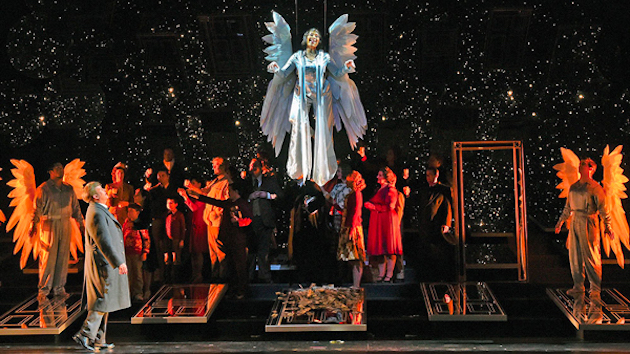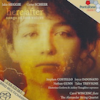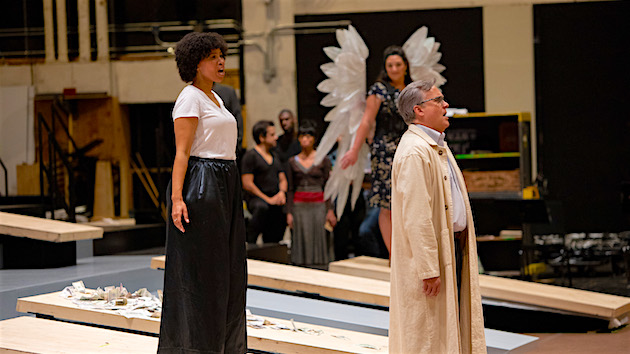
The first time librettist Gene Scheer sent composer Jake Heggie a lyric, for a song cycle called Statuesque, Jake Heggie’s response was blunt: “I don’t like it.”
For Scheer, an accomplished composer himself, that kind of feedback is not a problem. As he explained at a recent informative preview for educators and journalists, pleasing the composer is the librettist’s job. “If a libretto works on its own,” Heggie added, “it’s not a good opera libretto.”
This project, which opens at the opera Nov. 17, is the latest in a long line of collaborations between the two. It initially came about at the behest of conductor Patrick Summers, who has conducted all of Heggie’s operatic works, and will take the podium again for this piece. After the success of Heggie’s Moby-Dick, Summers approached the composer with the idea of doing a holiday-themed piece. It immediately made sense to Heggie. Year after year, The Nutcracker and A Christmas Carol bring in tremendous revenues, as do increasingly popular pieces like Mark Morris’s The Hard Nut, or Lauren Gunderson’s Christmas at Pemberley, which is now one of the most produced plays in the country. Why not an opera?
But what would be the right source material?
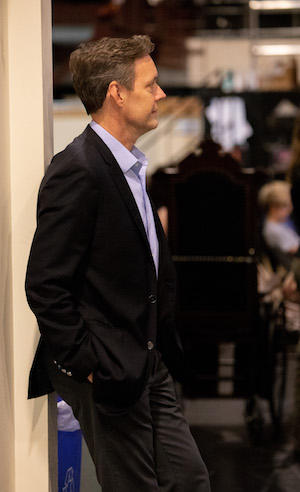
“The whole idea with opera is go big or go home,” Heggie said at the informative preview. “We pick universal themes in the opera house because it’s a big space. It has to make sense that people are singing that way. So what is something that has universal themes as well as a quality of great, American mythology? It wasn’t going to be Charlie Brown, and it wasn’t going to be The Grinch, even though I love those. It’s a Wonderful Life has something huge at stake in the middle of it. There’s a man thinking of taking his own life on Christmas Eve, a man who doesn’t realize his value.”
The film, based on a short story called “The Greatest Gift” by Philip Van Doren Stern, contains subject matter that likely has a powerful resonance for Heggie, who lost his own father to suicide when he was 10. It’s something he has spoken about openly. At a convocation address at Northwestern’s Bienen School of Music, Heggie said that music had been his lifeline at that difficult time. He began composing shortly thereafter, “songs for Barbara Streisand that she would never see.” And he practiced piano six hours a day. “Music,” he said, gave him “a voice, purpose, hope for something unifying and beautiful.”
Heggie feels the story of It’s a Wonderful Life and its protagonist, George Bailey, are timeless, but also much needed at this moment. “I do feel we are aching for good news, and something that brings us together with joy. Music and theater can do that. That’s one of the reasons this movie is popular every single year. It makes you believe in the goodness of people. The piece is really about the ripple effect of good deeds. People can think that sounds cliche and old hat with all the dark news around, but it really is true. We need those reminders now and then, and a way to come together in one of these great theaters, which is a place of reflection and community. The opera house is a community center, in my mind, and a place when we can come together and remind one another that we do need each other.”
Film was another early source of inspiration. “I was addicted to movies as a kid,” Heggie said, speaking to SFCV in a telephone interview. "I even collected silent movies. I used my paper route money, my lawn mowing money, babysitting money, in Ohio, to buy films through a mail-order catalogue. I bought all these silent movies. I had a projector and a screen, and I would just watch them over and over again. I loved silent movies. And I loved regular movies. In the summer I would ride my bike to the theater, and you could pay one time and stay there all day and watch every single showing. I loved black and white movies, color movies, musicals, dramas, comedies."
Opera these days is more and more cinematic, thanks to the use of projections, which in this case will be contributed by another returning collaborator, Elaine J. McCarthy, who provided the images for Moby-Dick and the team’s 2015 offering, Great Scott. Her images will enhance the staging of yet another frequent comrade in arms, stage director Leonard Foglia.
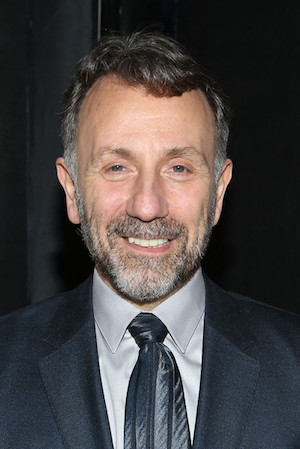
“One of the things that has been wonderful over the years,” Foglia explained, also speaking to SFCV via phone, “is that we come at it from three very different ways. With Moby-Dick, we developed it together from the very beginning. This one was handed to me further on down the line in the creative process, but in Moby-Dick we met before anything was decided, and we would sit there and talk about, ‘OK, how are we going to tell this moment? Jake, is it on you? Is it the words? Or will it be told musically, or is it going to be on me?’ We carved up those moments. For instance the whaleboats, that was on me. One of our first discussions on Moby-Dick, they said, we’ll have them all along the edge of the stage, and they’ll tell us about going into the whale boats. And I said, ‘It’s Moby-Dick. We have to go into those whale boats.’ And they said, ‘How will you do that?’ And I said, ‘I have no idea, but write it. Then it’s my problem.’ I always push for no limits in the writing. At one point Jake said, ‘how long do you need to sink the Pequod?’ And I said, ‘I have no idea. Just do what you feel is emotionally right.’ He gave me nine bars to sink the Pequod. Nine bars! [Laughs.] But things like that help to determine the style of project.”
Heggie’s early career path as an opera composer is well known, making a gift of some songs to mezzo-soprano Frederica von Stade while working in administration at the opera, and receiving his first important commission while still in that position, a public relations job once held by author Armistead Maupin. Heggie, who had followed through on his childhood musical dreams to study composition at UCLA and go on to a performing career as a pianist, may have been drawn to choose a day job in an environment with which he felt kindred.
Today, Heggie seems about as at home in the opera house as anyone you can imagine. Whether spontaneously kneeling at the feet of Sondra Radvanovsky backstage after a show — a gesture which most who witnessed her performance as Queen Elizabeth would say was entirely deserved — or dreamily mouthing the words as soprano Kearstin Piper Brown sings his music at the preview for It’s a Wonderful Life, passion bubbles up easily in Heggie, especially when discussing music. Not surprisingly, he is prolific, with more than a half-dozen operas to his credit, as well as numerous song cycles, chamber music, and choral works.
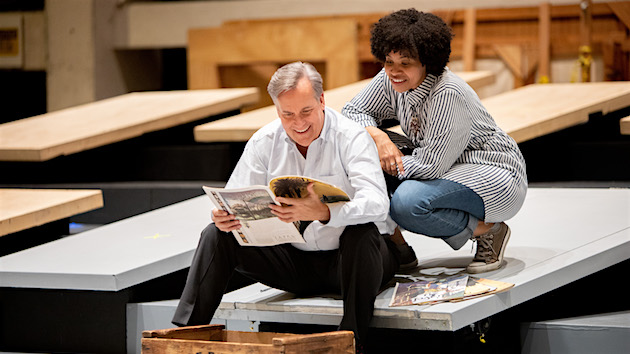
And he is not timid in choice of subject matter, whether the death penalty in Dead Man Walking, or the Faust story, which he and Scheer are tackling for Merola’s coming season. But even Moby-Dick does not rise to the status of beloved chestnut that It’s a Wonderful Life can claim. For many, watching the movie is a cherished annual event. Those of us old enough to remember life pre-DVR can recall anticipation mounting in early December, the question swirling around the household, “When is it on?”
But it’s not always easy to acquire the rights to Hollywood films, and here Heggie had a stroke of good fortune. “When Capra made this movie he was between studio contracts,” he explained, “and it was a time when he was trying with a couple of other directors to form his own company. But it didn’t work, and the movie was not successful, and he never copyrighted the script. So the script is in the public domain. But then Paramount took up the picture, and they trademarked the title, so we had to work with Paramount to get the rights to the title, but the script is wide open.”
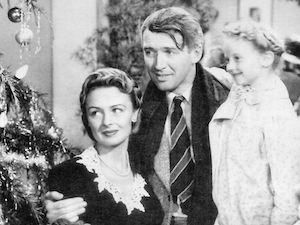
All who love the film have their favorite moments. (Are you a “Zuzu’s petals” person, or a “lasso the moon” type?) But according to Heggie, “the best way, to honor the original, is to do something fresh with it.”
For starters, “Clarence,” the angel who would save George Bailey from a terrible fate, is now “Clara,” because Heggie wanted to hear a soprano and tenor rather than two men in duet. There is also a magic, time-stopping hat, and the reasons for George Bailey’s crisis are revealed somewhat differently. No spoiler alert necessary, suffice it to say that a man who doesn’t mind beginning Moby-Dick by cutting arguably the most famous line in American literature, “Call me Ishmael,” is not afraid to shake things up a bit.
“The real challenge,” Scheer says, “was that Frank Capra’s movie was such a good movie, so idiomatically cinematic. As great as the script is, these indelible images tell the story, whether it’s Pottersville, or the close-up of George Bailey’s face when he’s at the train station and his brother Harry has just come back married, and George puts it together very quickly that Harry is not going to take over the Building and Loan, and George is going to have to stay on. Capra communicates that with a close-up. But we’re in the business of music, so that was the challenge all the way through, so you’re cutting, cutting, cutting. You don’t need so many words. You don’t need to tell the audience everything, you need the audience to feel everything. That’s what music does so well, and what Jake’s music does so beautifully.”
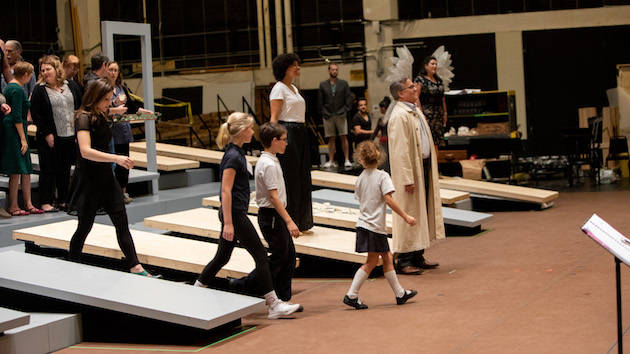
If there is a flaw in this near perfect storyline, leave it to San Francisco Opera’s indomitable dramaturg, Kip Cranna, to find it. “The sequence of returning to so many places to see what life was like without George goes on too long,” he says. Scheer and Heggie agree. Some edited moments may be mourned over, others not so much. The tragically-unmarried-librarian version of Mary Hatch, Donna Reed’s character in the film, “is the only moment in the movie everyone laughs out loud,” Heggie says, and you won’t see it onstage. Whereas the poignant cameo of Mr. Gower the pharmacist was a favorite of Scheer’s, but is likewise absent. No matter. Both were cut because they did not serve the story in this version.
This kind of dramatic austerity shows that Heggie is, like Verdi and Puccini before him, first and foremost a man of the theater, which is perhaps why Heggie-Scheer collaborations have legs — in other words, repeat performances. This season will see Moby-Dick in Philadelphia, San Jose, and Chicago, and Three Decembers is in Nashville, Binghamton, and San Diego, while Dead Man Walking is in Wilmington, Glasgow, Cardiff, and three regional houses in Germany.
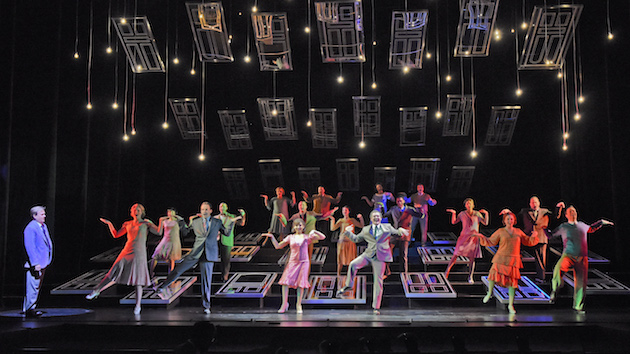
In terms of classifying Heggie’s music, Cranna puts it about as far as you can get from a cliched idea of atonal, inaccessible “contemporary” opera, and while Heggie understands well the difference between the musical theater vocal technique and that of an opera singer, his choice of director known for his work on Broadway is a good indication that he sees musicals and opera as a delightful fusion. Heggie dedicated the score of Moby-Dick to Stephen Sondheim. And while Sondheim famously said he did not want Sweeney Todd to be done by opera singers, Heggie brings many aspects of musicals unashamedly in the front door. The show will have a dance number, dialogue, and the recorded voice representing God (or Universe) will be that of living Broadway deity Patti Lupone.
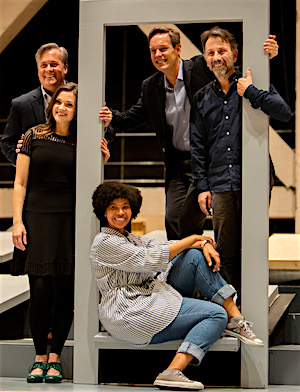
As for the drama, Foglia, whose Broadway credits include a revival of the suspenseful play Wait Until Dark, and who is also an author of suspense novels, says that the more continual presence of the angel, Clara, adds suspense. “It’s her job to find out what drove him to that moment on the bridge.” Heggie sees Clara’s struggle as central to the story, and a fundamental question for humanity: how can we help one another?
The production in San Francisco will be the third bite at the apple for this opera, after its premiere with co-producer Houston Grand Opera in 2016, and a version at the Jacobs School of Music at Indiana University, which is also a co-producer. (The Jacobs School is also a co-producer of the composer Mason Bates’s opera, The (R)evolution of Steve Jobs, which will come to San Francisco next season.) Numerous changes have been made since Houston, some of them expensive technical improvements made possible by generous donors, and others changes of the narrative that the artistic team feels better serve the story. “We don’t get Broadway previews, where you get to work on it day after day in front of an audience,” Heggie says. “New operas are shot out of a cannon at the audience on opening night. You have to wait for separate productions to make changes.”
One constant in the various productions is Foglia’s instruction to the casts. “Forget the film,” he says. “Please, never start a sentence with, ‘but in the film ...’”
This cast will include tenor William Burden singing George Bailey and baritone Rod Gilfry as Mr. Potter, both men having previously sung seven roles with the company. Canadian soprano Andriana Chuchman sings Mary Hatch. At the informative preview, excerpts were sung by Kearsten Piper Brown, who will sing the role of Clara on Dec. 9, with all other performances sung by Golda Schultz. Schultz, who is South African, and Piper Brown, are both women of color. This elicited comment from one of the educators attending the preview.
“In trying to get the kids interested,” she shared, “I have emphasized diversity and inclusion, so it was very important to me when I was recruiting kids to come to the dress rehearsal, that you had a lead who was African-American.”
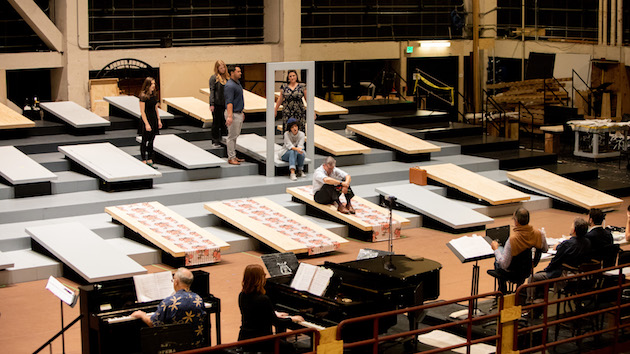
“It’s primary in our minds when we’re writing,” Heggie said. “That we’re creating roles that can be done by many different people, regardless of how they look, the color of their skin, their nationality. Why can’t George and Mary be people of color? From the start, we want to demand there is diversity on the stage. In Moby-Dick, in Dead Man Walking, there was diversity on the stage. It’s very important, so that people can see themselves. We’re about to embark on a new story for 2021 in Houston. It’s a Civil War story. Like the movie Hidden Figures a 100 years earlier. It’s about an underground spy network of women in the Civil War. A young, African-American woman was a house slave for Jefferson and Maria Davis, and was in cahoots with this amazing woman named Elizabeth Van Lew, smuggling information to the North. She was a genius with a photographic memory. She remembered every conversation. It’s an incredible story. It demands diversity. It’s a strong feminist story.”
Heggie and Scheer went on to discuss their upcoming Faust story for Merola, which Heggie describes as somewhat of a “lesson in empathy,” as Faust (Fabian) has the chance to inhabit a variety of souls. Diversity is important enough to this project that Heggie and Scheer have written in the score, “It is very important to the composer and librettist that the cast represent the world and be as diverse as possible.”
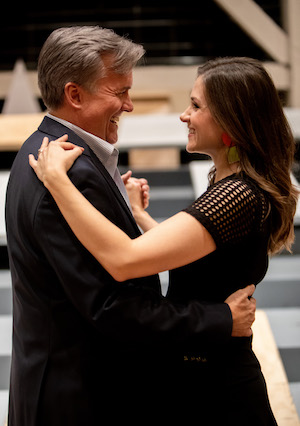
Despite the fact that it took place Nov. 1, the day after Halloween, at the end of what was surely a long day for the teachers, the room at the preview seemed full of energy as a palpable mutual admiration flowed between the artistic team and the educators, facilitated by the convivial Director of Education, Ruth Nott, with Cranna as master of ceremonies. A particularly nice moment came when Scheer told the teachers to be on the lookout in the opera for a character named “Mr. Ruffino,” a tribute to Scheer’s own high school chorus teacher, whom he had not been in touch with in decades, but contacted on Facebook, writing, “I hope it’s not too late to say ‘thank you.’”
This is the kind of good will that seems to be swirling around the production, which has inspired the “Earn Your Wings” initiative, a program in support of organizations dedicated to helping families and individuals who may have experienced or be at risk of homelessness. The Saturday afternoon after Thanksgiving, in the courtyard outside the opera, the “Bedford Falls Makers Market” will support the initiative by offering food trucks, handmade gifts and family activities.
In A Christmas Carol, Ebenezer Scrooge is redeemed by making amends for his past wrongs, and vowing to live his life with more consideration for others. George Bailey has the simpler, but perhaps more difficult task of recognizing the good in him that is already manifest. And this is what makes this story such a good fit for Heggie, whose sense of wonder beams forth continuously, as a kind of self-generating, dedicated follow spot.
With performances running through Dec. 9, this production has all the ingredients for an enjoyable night of theater and a fun holiday outing for families. But at a time of year when people sometimes struggle, tiptoeing like George Bailey dangerously close to the precipice, this reinterpretation of a beloved story by a dynamic, close-knit group of creators, might also do more. It might give us something wonderful.
